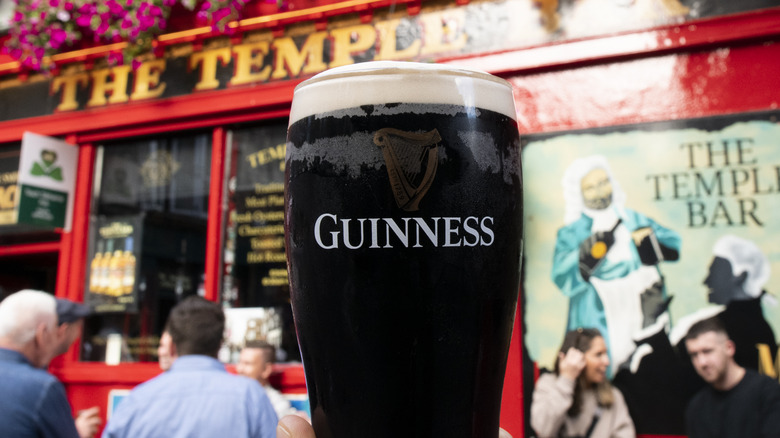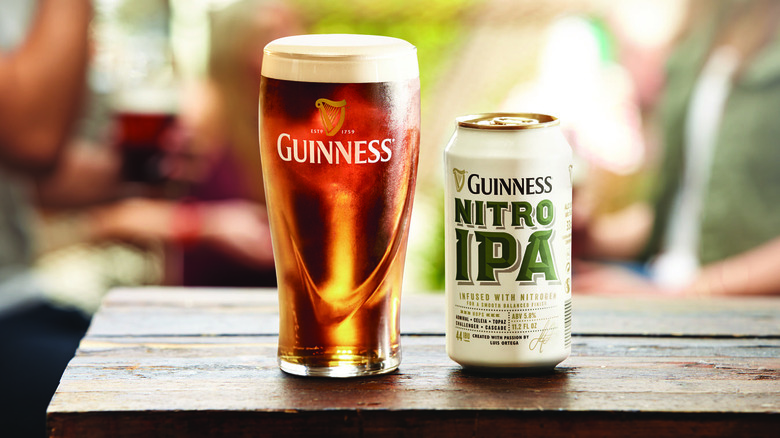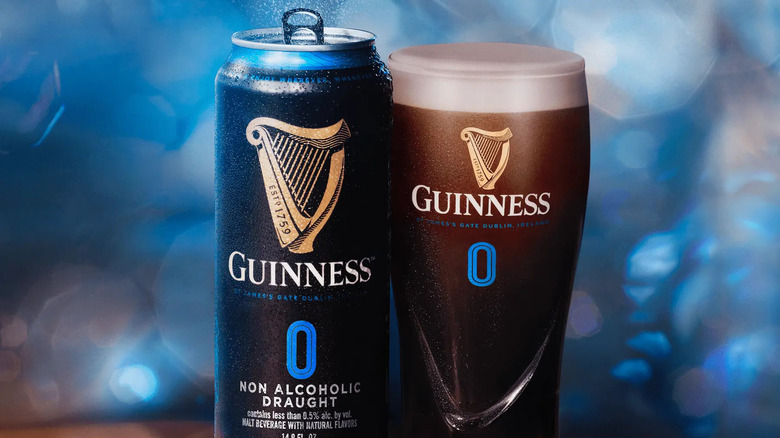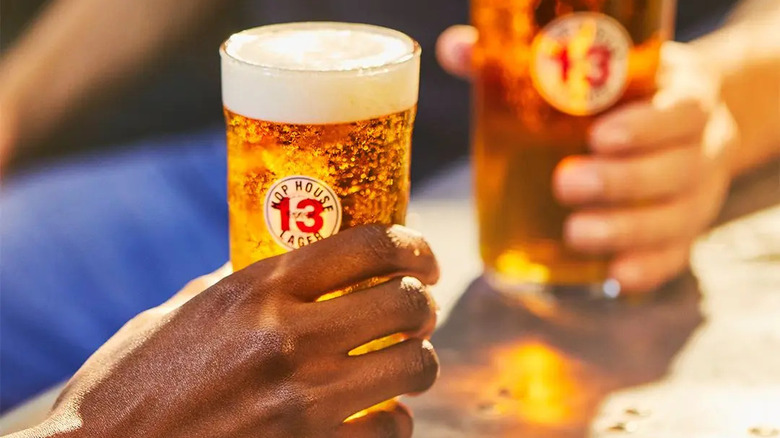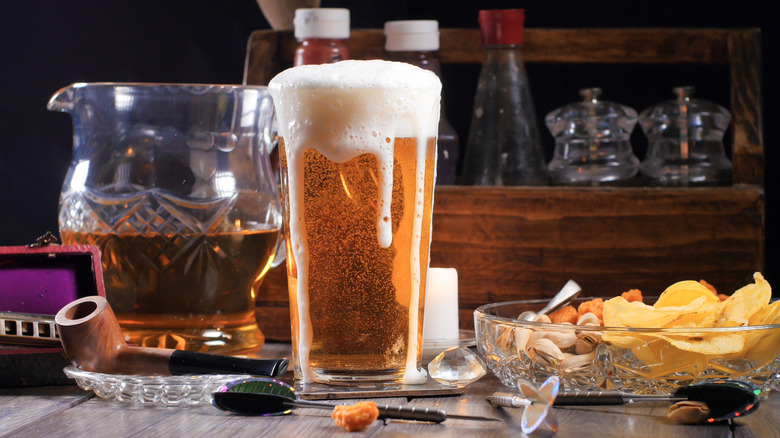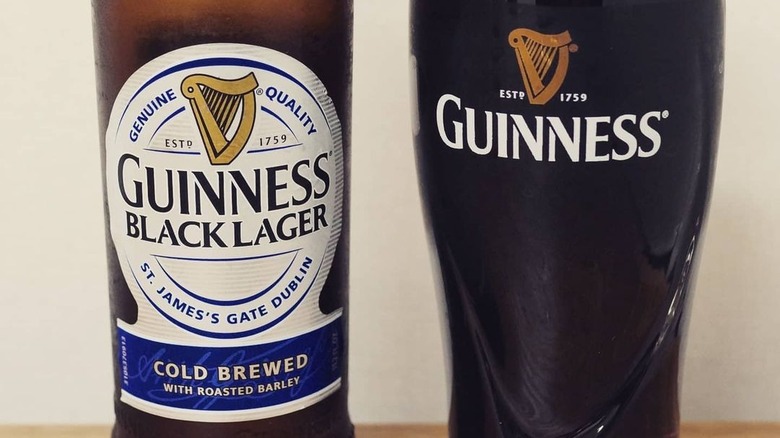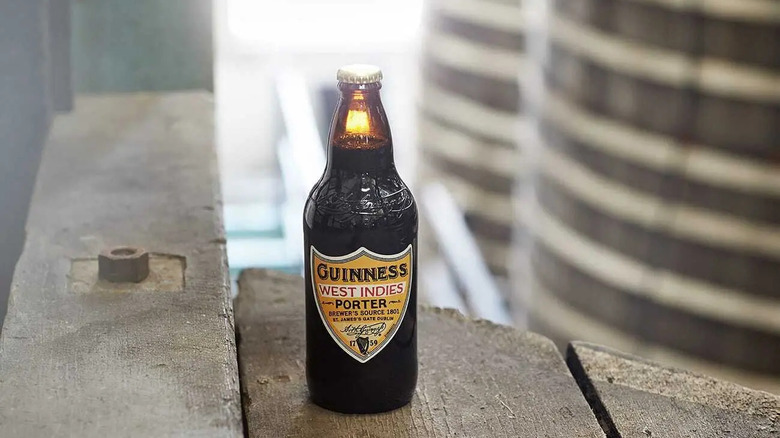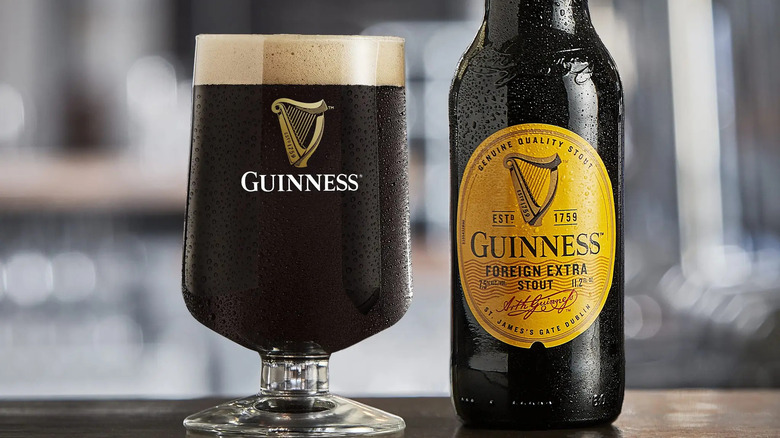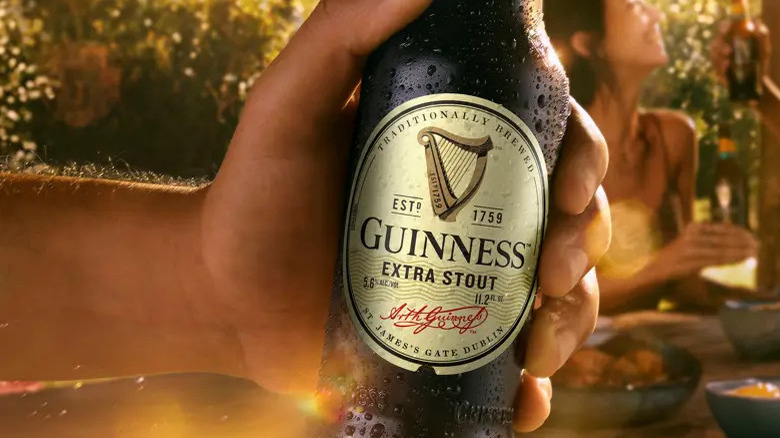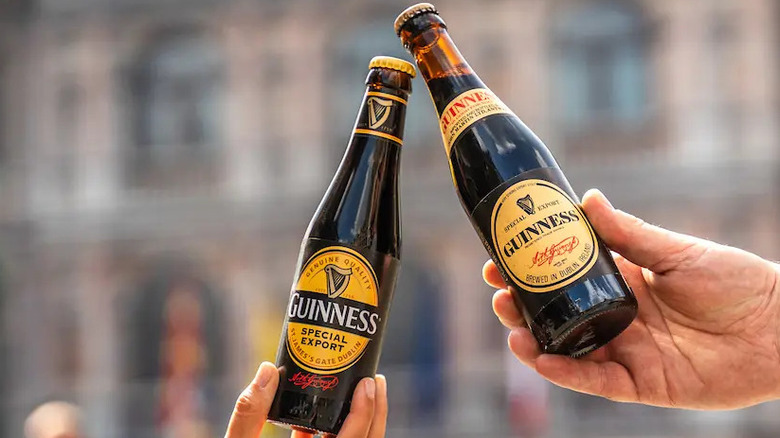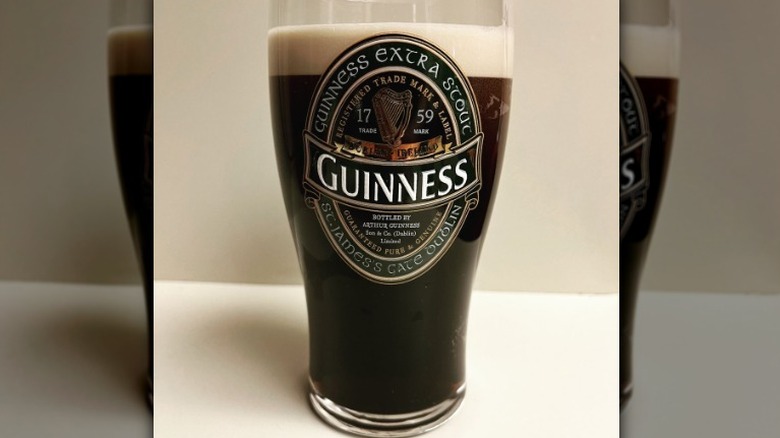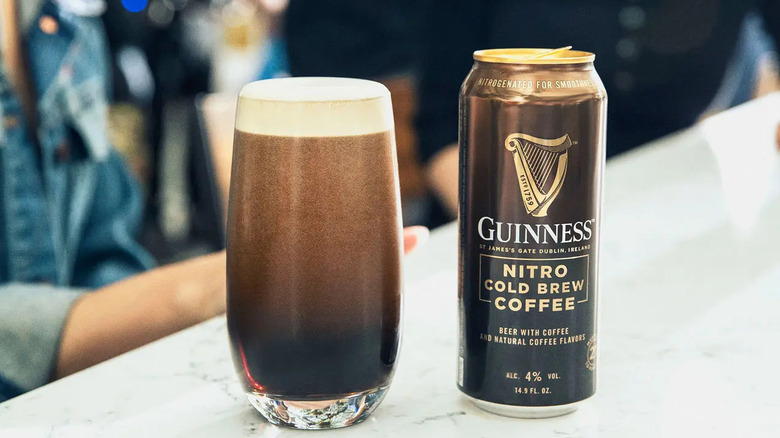11 Guinness Beers Ranked Worst To Best
Whether gearing up for St. Paddy's Day or just in search of a classic beer from across the pond, few brews can stand up to the lasting legacy of Guinness. While best known for its legendary Irish stout, the St. James's Gate brewery in Dublin has been producing numerous beers since originally opening in 1759.
The company, which is now owned by British company Diageo (Diageo owns other high-profile alcohol brands like Tanqueray, Johnnie Walker, Smirnoff, and Captain Morgan), has expanded around the world, opening breweries to not only make it easier to sell to regional markets but to make regional beers, as well. There's even a brewery in Baltimore, Maryland.
However, in order to focus exclusively on the best and worst beers coming from Guinness, we're only going to include the beers that are brewed in Dublin, Ireland. Thankfully, most of those beers are already readily available throughout the United States, so while we won't be including American brews like the Baltimore Blonde or the Over The Moon Milk Stout, there will be plenty of Irish-based beers to consider, discuss, and rank from worst to best.
11. Guinness Nitro IPA
Nobody does nitrogen-infused beers like Guinness. Thanks to the company's patented widget technology, there is a small device that, when a can or bottle is opened, activates, surging to the top as it infuses the entire beer with nitrogen, which gives the beer its creamy, smooth taste and head. For whatever reason, beers in the United States don't utilize the widget (even though plenty of other non-Guinness breweries in the UK and Ireland do). Instead, the nitrogen is added to the top of the container, which then requires you to pop the top quickly and pour the beer into a glass, which delivers a lackluster result.
With its nitrogen widget technology, Guinness decided to experiment, adding nitrogen to other styles of beers. Naturally, it turned to the India Pale Ale, which has taken on a life of its own inside the United States. While nitrogen has worked with other beer styles and brands, including the Bellhaven Scottish Ale and the Boddington Pub Ale, there aren't many IPAs utilizing nitrogen.
It's for a good reason. The Guinness Nitro IPA fell completely flat. This is one style of beer that doesn't need a milky, creamy head. The hoppy aspect of the beer lends closer to a traditional British IPA, with a mild hop profile (which gives it the relatively low 44 IBU) and a milky, pine needle taste. Perhaps if Guinness made a juicy or hazy IPA this would have worked better, but it's terrible as-is.
10. Guinness 0
We do applaud Guinness for its experimentation. The brewery best known for one specific beer has tested out various recipes and beer styles in recent years, which is something not many other macro breweries do. So even though not all the beers turn out well (we're talking about you, Nitro IPA), at least they are trying new things and not just pumping out a new IPA every three months. The world needs more variety.
So it isn't a surprise that Guinness turned its head to the zero alcohol segment of the market. More and more breweries have been jumping on board, which is great news for those looking to spend time with friends and have a beverage in their hand without feeling left out.
Zero-alcohol beers came about back during prohibition and, at the time, were known as "near beer", as they couldn't legally be called beer, and they couldn't have more than half of a percent of alcohol. This particular zero beer (or near beer) leans into the classic Guinness Stout recipe, but by removing the alcohol, it's also removing flavor. Unlike zero-calorie sodas, which can replace sugar and corn syrup with artificial sweeteners, there isn't much brewers can do when stripping away the alcohol. We do love that Guinness has this as an option, but in terms of pure taste, it just isn't able to stand up to the other strong performers it has in its Dublin brewery lineup.
9. Guinness Hop House 13
This is one of those beers that you'll probably need to be in Ireland to enjoy. However, if you do manage to find yourself pulling up a stool at the on-site brewpub in Dublin when asking for a pint of Guinness Hop House 13, you're going to discover this beer is essentially a lager made with IPA hops. Typically, lagers are going to be crisp and clean with minimal taste on the back end. This particular beer is going to have some of the hoppy bitterness, which does help lend this beer (which is categorized as a lager) more flavor.
Made as one of the experimental beers at the Guinness Brewery in Dublin, this is a fantastic beer for anyone who loves IPAs and finds lagers to just be a bit too "watered down." It is a sweeter beer, with a crisp, dull-peach taste to it. The hoppiness isn't overpowering, with a pine taste that leans into a subtle toasted-biscuit malt finish.
If this beer sounds like something you'd love to try out but flying out to Ireland isn't exactly in the cards, consider grabbing a Firestone Walker Pivo, which is a dry-hopped American pilsner, that delivers a similar taste profile.
8. Harp Lager
While this beer is available year-round, you might not see much of it until St. Paddy's Day is right around the corner, and then grocery stores put up massive displays of Guinness and Harp.
This beer first hit the market back in 1960, as more and more beer-drinking Irish consumers were turning to lighter British lagers. So, Guinness, as well as a handful of other regional Irish brewers, came together and started to produce Harp using its Great Northern Brewery. However, after Diageo took control of Guinness, in a cost-cutting measure, the company closed the Great Northern Brewery and shifted production to Dublin.
The interesting thing about Harp is that, when drinking in the United States, it's exported via Diageo and branded with the Guinness labeling (it is made in the Guinness brewery, after all). However, if you were to drink it in Ireland, the brewing would be handled by Hydes Brewery.
Regardless of the brewery, the recipe is identical. It is a clean, crisp lager made with malted barley, barley, and hops. This gives it a slightly more robust, less sweet taste commonly found in American lagers made with corn or rice. In addition to being a fine alternative to numerous variations of the Guinness Stout, Harp is commonly used to make the classic black and tan beer cocktail.
7. Guinness Black Lager
If you want the taste of a black and tan in a single bottle, Guinness Black Lager is about as close to that taste as you can get with a single pint glass. In fact, there is a number of interesting tastes going on here. As a lager, it is made with lager yeast. This means it is cold brewed (lagers are made with cold-fermenting yeast and take longer to make, while ales are made with warm fermenting yeast and are brewed faster) beer that takes on some floral complexities, thanks to the Cascade and Saaz hop strands. These are mild hop strands so you won't have a strong bitter taste to them. It's just enough to add a subtle citrus taste to the lager. The beer is then brewed using malts you are more likely to find in a stout or porter.
There's a lot going on with this beer, and that isn't necessarily a bad thing. If you were to take a slightly burnt English biscuit and top it off with a dab of marmalade, that taste wouldn't be all too different from Guinness Black Lager.
The cold brewed lager yeast does help give this beer a smoother finish, which is a good thing because if they had gone overboard with the malt it would have given it a lingering mouthfeel. We won't call this a classic like other Guinness beers, but it's absolutely worth checking out.
6. Guinness West Indies Porter
Finally, a beer by Guinness that is actually marketed as a "Porter." In terms of how it's made, it isn't all that different from the next beer coming up on the list (the Foreign Extra Stout). Basically, Guinness needed to find ways to get its beer to other regions around the world prior to refrigeration, and this beer is a take on one of those transport methods.
Now, if you've ever had a Guinness in other countries, such as Jamaica, Malaysia, or pockets of Africa, you likely noticed the Guinness had a sweeter taste to it. That is because those beers are made with regional ingredients and for a local palette. In the past, if you loved that unique tasting Guinness and wanted to experience it, you had to physically hop on a plane and fly to Southeast Asia or the Caribbean. The Guinness West Indies Porter changes that, as the brewery has bottled the taste and now distributes it (although the West Indies Porter is a bit harder to track down).
In many ways, this beer is like taking the non-draught version of Guinness and mixing it with some sugar cane water. There is just that extra heightened sweetness to it. It's an interesting taste with the sweetness blending with the Guinness chocolate. It also has an almost Irish red ale visual style to the beer.
5. Guinness Foreign Extra Stout
While easy to do, don't confuse the Foreign Extra Stout with the Extra Stout. That "Foreign" makes a very big difference in the taste of the beer. Back in the day before refrigeration, shipping beers around the world was difficult, as the beer would often spoil. In order to help keep the beers lasting longer, breweries started packing the casks with hops. This eventually led to the development of the India Pale Ale.
Naturally, lovers of Guinness wanted to enjoy their favorite beer outside of Ireland, but Guinness didn't keep long, so the casks were also stuffed with additional hops. This gave the stout a stronger, bitter taste, reflective of the hops traveling with the beer. It is also the origin of the Guinness Foreign Extra Stout. This is the boldest, most robust beer in the Guinness lineup (not counting the occasional experimental beer Guinness puts out every so often). At 7.5% ABV, it has a significantly higher alcohol by volume than regular Guinness, and everything about the beer is more intense.
The hops give it a subtle bitter bite, while the added malt infuses the beer with a burnt chocolate taste that is offset with caramel sweetness. If you are a lover of Guinness Draught, this beer may be too robust for your liking. However, if you've been around the block a few times with your porters and you enjoy a malty beer with hits of barley and minimal sweetness, you will love this beer.
4. Guinness Extra Stout
Guinness Extra Stout is teetering into the porter category. As stouts and porters share a number of similarities, there is often a little bit of leeway in terms of branding. And, because Guinness is the king of stouts, we're going to let it slide.
The beer itself is based on an earlier Guinness recipe (pre-dating the popular Guinness Irish Stout recipe) that was first whipped up back in 1821 and, at the time, went by the name Superior Porter. So, yeah, we're going to just say this is a porter with a stout name tag.
But what does it taste like? There are very much the familiar chocolate and coffee notes to this Extra Stout, but it has a stronger, more pronounced roasted malty finish to it. Basically, remove the nitrogen from the stout, and rough the taste up a bit around the edges. No, literally, you'll feel the malty roast flavors along the edge of your tongue.
As a stout (porter) you don't need to fully chill this beer. In fact, it takes on some interesting complexions when you drink it at room temperature. The warmer, sweet fruity taste is emphasized, as is the roasted malty molasses taste at the end. We think the smooth traditional Guinness tastes better, but if you're a lover of winter porters without the hefty ABV kick (this clocks in at 5.6% ABV), the Extra Stout is absolutely a fine beer to check out and enjoy.
3. Guinness Special Export
Whenever Belgian influence is properly utilized it's a win for beer drinkers everywhere. In our humble opinion, Belgium makes the best beer (sorry, Germany, you have great beer, but the Purity Law limits the style of beers you're able to make, which is why Belgium slides in as the top beer country in the world).
The Special Export was first shipped to Belgium after the Second World War takes the legendary Irish stout and blends in the stronger, Belgian flavors commonly found in a Belgian dubbel style of beer. There are the familiar coffee and chocolate flavors, with a robust, burnt toast maltiness to it. There is also a deep, deep sweetness as you let it sit in your mouth, along the lines of a prune molasses. The malty bitter finishing end of this 8% ABV is a bit scratchy on the tongue, but in a good way. In many ways, the beer tastes like you took the traditional Guinness and cut it with a Trappist ale. The beer is both familiar and different, all at the same time, which is why it's so exceptional.
2. Guinness Draught
The nitrogen helps take this beer to an entirely new level over other stouts on the market. For many, it is the first stout they ever try. It very much is a gateway beer. Long before the craft beer explosion in the United States, if you wanted to stand out at a party, you showed up with a (cringe) Red Stripe (slightly less cringe) Heineken, or (cheers) a Guinness.
The nitro infusion really does make that much of a difference. Nitro infusion might be one of the most underrated beer technologies on the market. The way it can take any beer and infuse it with a creamy mouthfeel is truly delightful. It doesn't work with all kinds of beer, which is why it is most commonly associated with stouts, but it just adds something special to the beer. And English/Irish beers seem to do this better than any others. Guinness cans/bottles take advantage of an included widget that releases nitrogen once opened. Everyone else pumps nitrogen in the top of the bottle and then requires a hard pour to infuse it, although the effects are never as satisfying. Nitrogen and Guinness now go together like peanut butter and jelly, even though it wasn't added to the famous stout until 1959 (right around the same time Guinness was beginning to produce the Harp Lager).
1. Guinness Nitro Cold Brew Coffee
No, no, you're not reading this incorrectly. We really are ranking the Guinness Nitro Cold Brew Coffee as the best beer put out by the company. And maybe some of this ranking is in part to just how surprised we were at how good it was.
We've had plenty of coffee beers over the years. We've even had coffee beers that attempt to utilize a nitrogen infusion, with varying results. So, we assumed we knew what a coffee beer would taste like. This beer absolutely blew every other coffee beer we've had away, and it's not even close.
Now, there isn't any real level of caffeine in the beer, so don't think you can down a couple of these in the morning for a jolt of energy. You'll need to take a nap more than anything else. But in terms of delicious coffee flavor, this beer is outstanding. Truly. You could probably crack the beer open, pour it out (it has that fantastic Guinness pour, just like the Draught), and have a coffee lover sample it, and there is a good chance they wouldn't guess it was a beer. It's true coffee beer perfection.
There's nothing artificially tasting with this beer, either. It doesn't need a ton of lactose or other additives, as nitrogen takes care of the creamy elements. And the ABV is nearly identical to Guinness Draught, so it's not like you're getting some watered-down beer.
